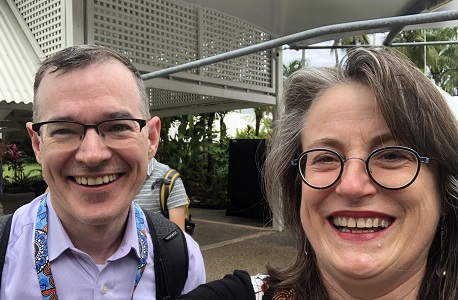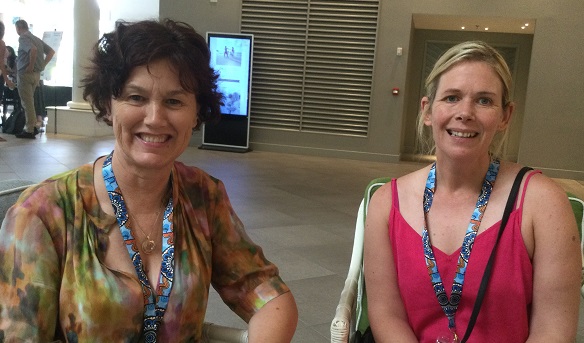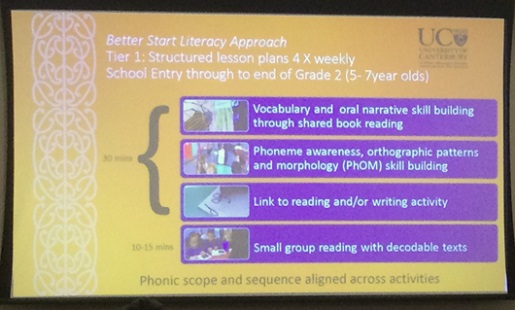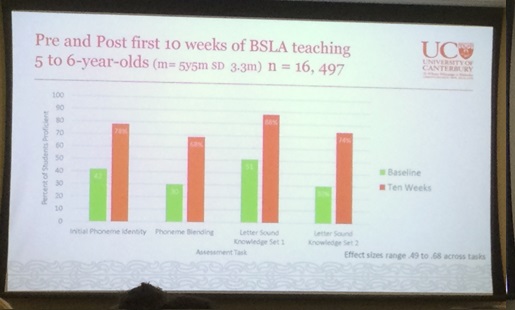Society for the Scientific Study of Reading conference: day 3
0 RepliesI’ve finally found time to summarise the sessions I attended on the last day of the SSSR conference. Here’s what I learnt (sorry if I’ve misunderstood anything).
Parent advocacy about literacy in preschools
Dr Stacey Campbell from Queensland University of Technology said preschool teachers report increasing pressure from parents to teach literacy skills. She collected data about parents’ literacy beliefs and expectations from six early childhood services, using a survey and follow-up interviews.
Most parents agreed that both phonics and what Dr Campbell called play-literacy learning (I’m not sure exactly what that includes) were important. Parents of kids in school-based settings were more likely to endorse formal phonics instruction. Most parents wanted play-literacy, rhymes and name writing (poor little Phoebe, Niamh, Jose and Xavier). At home, they used a range of home literacy practices, as per the above graph (sorry it’s a little blurry). I was a bit sad to see that the most common home literacy practice was “recites and sings the alphabet song”, having known so many learners who get letter names and sounds mixed up.
Dr Campbell was asked what preschools in Australia are required to teach regarding literacy. She said we have an early years learning framework, but it’s very generalised/broad/open to interpretation, and what’s taught can depend on whether the educator has a degree or a diploma.
Implementing the Ontario Right To Read report
In February 2022, the Ontario Human Rights Commission released the Right To Read report, finding that reading instruction in Ontario was not meeting student needs. It made 157 recommendations e.g. stop using leveled readers, cueing, and running records, and introduce phonemic awareness and phonics work with decodable text, plus screeners, small group (Tier 2), and individualised (Tier 3) intervention.
A/Prof Deanna Friesen from the University of Western Ontario surveyed 30 teachers about their level of confidence in implementing the report’s recommendations. Beliefs were raised as one major barrier, but respondents felt teachers would try things they thought would make a difference. Other major barriers were lack of training and resources, and class sizes. Providing relevant training and resources were considered the most likely facilitators of change.
Some of the teachers surveyed had done evidence-aligned training since the release of the report, more than half with external providers. Some had funds to buy evidence-aligned resources, but some did not. Some had good resources, but didn’t know how to use them, or feel they had time to learn.
Teachers commented that initial teacher preparation needs to improve, as they paid for their degrees, but didn’t get value. They wanted training including coaching, support and concrete examples at school level. They wanted the school system to provide a list of quality training and resources, and relevant funding, rather than teachers having to find, and sometimes fund, training and resources themselves.
Dr Friesen said the Right To Read report had been an influential catalyst, but implementation will depend on listening to educators about their needs for success. The new 2023 Ontario Language Curriculum is better aligned with scientific research than previous versions, but Ontario school boards have a lot of control, which leads to variability in teaching, and sometimes non-co-operation with top-down directives.
Reciprocal learning relationships in reading and maths
Prof Arne Lervåg of the University of Oslo spoke about statistical models for measuring reciprocal relationships between phonological awareness and beginning word reading, and between Approximate Number Sense (e.g. having a rough idea which picture has the most dots) and number knowledge.
569 Brisbane beginning readers’ skills were measured five times at six month intervals, and the data analysed. The results support a causal relationship between phonemic awareness and word reading in the early school years, but (surprisingly) not between Approximate Number Sense and number knowledge.
Aotearoa/NZ Better Start Literacy Approach
Prof Gail Gillon of Canterbury University spoke about the implementation of the Better Start Literacy Approach with five-year-olds across Aotearoa/New Zealand. Both the World Health Organisation and the UN are calling for systems-wide action on literacy teaching. COVID-19 had profound adverse effects, especially for poorer kids. Advocacy for the science of reading across schools is critical.
Better Start uses a “Braided Rivers” approach, taking into account indigenous and scientific knowledge, and has ecological, cognitive and psychological streams. Culturally responsive teaching practices and resources, positive learning experiences and family engagement are key in high deprivation contexts. A strengths-based approach is needed, with quality professional development, and online assessments adapted for children with special needs.
Better Start was developed between 2015 and 2019. Feedback from schools about its positive impact led to its national rollout commencing in 2020. It’s now used in more than 833 schools, especially in high deprivation areas. 36,500 teachers and literacy specialists have done Better Start online training, for which they are awarded a micro-credential. They are required to pass the course, which provides some quality control. The training is professionally-produced, with subtitled videos, and available to all professions.
Tier 1 structured lesson plans are implemented four times weekly from school entry until the end of grade 2. See photo at right for the lesson components. They’ve developed and provide culturally relevant Ready To Read Phonic Plus readers, plus there are some free online readers.
In the first 10 weeks of the program, Tier 1 of Better Start aimed for 30 minute lessons per day. Most teachers managed this, with 80+% including all key lesson components.
In one research cohort, 28% of children could identify initial phonemes at school entry. After 10 weeks of teaching, this rose to 72%. About 20% of kids could blend phonemes at school entry, but 57% after 10 weeks of teaching. Children from Maori and Pacific Islander backgrounds began with lower skills, but caught up with peers.
Children start school on their fifth birthday in Aotearoa/NZ, so teachers are used to scaffolding/differentiating to support new children, and this is a key part of the Better Start program. Schools are now usually choosing between Reading Recovery and Better Start. Reading Recovery is in decline, with only 41% of schools, whereas 46% of schools are now doing Better Start.

Phonemic Proficiency and word reading skills
Dr David Kilpatrick from the State University of New York at Cortland has been working with the WIAT-IV test developer and a statistician on a timed Phonemic Proficiency subtest involving phonemic manipulation. Remembering written words requires rapid and automatic access to their sound structure, in order to link sound to print.
Pseudoword decoding subtest results were the strongest predictor of performance on word-level reading subtests and the oral reading fluency test, though phonemic proficiency scores added some validity for ages 12-17.
Set for Variability: relationship to word complexity and grade/age
Set for Variability (SfV) is the ability to figure out a word’s actual pronunciation from the way it’s said when it’s decoded (the “spelling pronunciation”). SfV is a robust predictor reading skills.
When children start learning to read words with more than one syllable, they have to contend with unstressed syllables, syllable boundaries, and words with prefixes and suffixes, all of which can make decoding words harder. If one pronunciation doesn’t make sense, the child has to try another pronunciation. It’s a mystery why some kids do this easily, and others don’t.
A/Prof Laura Steacy of the Florida Centre for Reading Research discussed studies with school beginners and grades 2-5 students which examined how well SfV predicted word reading skill. SfV was more important for the older children, which might be related to having had experience of reading instruction. The transparency of words also made a difference.
She said there were three main developmental hypotheses about SfV:
- It’s highly related to phonological processing, through the process of phonological clean-up.
- It’s a metalinguistic skill, and significantly overlaps with phonemic awareness and vocabulary.
- It captures dynamic changes in word reading, and has a bidirectional relationship with word reading.
The results of the studies A/Prof Steacy discussed tend to support hypothesis 3.
I’m not sure I’ve done this paper justice, so if you have questions, please ask lsteacy@fcrr.org.
Pronunciation correction and Set for Variability

Mispronunciation Correction Tasks (MCTs) are used to evaluate a reader’s Set for Variability, and are strongly correlated with polysyllable word recognition. Most polysyllable words contain something, usually a vowel, needing phonological cleanup (e.g. changed stress).
A/Prof Devin Kearns of the University of Connecticut’s research explored whether this is because SfV gives the reader access to a word’s phonology and semantics, or whether orthographic information plays a greater role.
When children sound out a word incorrectly, they can correct it by trying (a) different sound(s), or using knowledge of vocabulary and/or phonotactics/orthotactics (permissible sound/letter sequences). Kearns developed an Incorrect Pronunciation Correction Task (IPCT) using words/pseudowords differing by one phoneme. The incorrect part of the mispronunciation had a different spelling from the target word (e.g. “planket” for blanket). Sometimes a sound’s manner was changed (e.g. a stop sound became a fricative), in others a sound’s place in the mouth was changed (e.g. alveolar to velar), and in others voicing was changed.
117 grade 3 and 4 children’s IPCT scores didn’t predict their word reading better than their MCT scores. This suggests SfV has an orthographic component, and that print and sound continue to interact in the process of decoding words. Item analysis showed kids could correct a word more easily if a sound’s manner changed (e.g. /t/ to /s/), rather than changing its place (/t/ to /p/) or voicing (/t/ to /d/).
Eye tracking evidence of mispronunciation correction
Eye movements give clues to cognitive processes during reading. The eyes fixate for longer, and look back more, at long, uncommon or unfamiliar words. Dr Lyndall Murray from Macquarie University explored whether kids’ eye movements suggest they are correcting mispronunciations as they read.
Four classes of Year 5 students were taught 16 novel spoken words used at ‘Professor Parsnip’s invention factory’. Each class learnt a different pronunciation of the words. For example, one class saw a picture of a contraption with an arm and a sponge for cleaning fishtanks, and were told it was called a ‘vake’. Another class was told it was called a ‘vike’. They then had to read the words, and a set of untrained words, in sentences that included contextual information e.g. ‘The fish in the dirty tank swam around the vaik as it worked’, and in neutral sentences. For the kids told it was a ‘vake’, the spelling of the word was considered regular. For the kids told the machine was a ‘vike’, the spelling was considered irregular.
The children’s eye movements, as well as their audible mispronunciation corrections, suggested that they were correcting mispronunciations when reading irregular words, even when reading silently. This research has been published here, if you’d like to find out more.

Targeted and explicit spelling teaching
Spelling is important for its own sake, but also in compositional writing, with 24-43% of the variance in NAPLAN writing data explained by spelling. It is more influential than grammar or punctuation.
Dr Tessa Daffern of the University of Canberra researched the usefulness of spelling error analysis data in teaching spelling. A 10-week intervention study involved 572 Year 3-6 students in 31 classes across four schools.
Teachers from two schools participated in intensive professional learning about spelling informed by Triple Word Form Theory, which proposes that children draw on phonological, orthographic and morphological knowledge from when they first begin to learn to spell. These teachers then used spelling error analysis to plan and implement spelling instruction. Short, sharp, focussed teaching took 15-20 minutes per day. The intervention included spaced learning/review so there were opportunities to consolidate skills, handwriting activities, visible learning intentions and immediate, specific and ongoing feedback.
Teachers from the two other schools taught spelling in a ‘business as usual’ way, for about 30-60 minutes per week. Teaching was mostly via rote-learning and/or incidental phonics, although one teacher was interested in and knowledgeable about spelling, and used spelling error analysis to inform teaching. Two classes had no spelling instruction.
The intervention groups’ spelling improved significantly. Only one comparison class had significantly improved spelling: the one whose teacher used spelling error analysis to inform teaching (surprise, not).
More thoughts on Set for Variability
Professor Anne Castles from the new Australian Centre for the Advancement of Literacy at ACU was the discussant for the sessions about Set for Variability. She spoke about Carsten Elbro’s hypothesis that we store a ‘spelling pronunciation’ (how you’d sound a word out when first encountering it) for a word when we learn its printed form. It’s hard to test whether this is actually stored in the lexicon, or assembled on the fly by converting graphemes to phonemes, but that could be tested with timed tasks in the lab.
Lots of research on Set for Variability has been done on adults, but it’s hard to know how relevant this is to children, who have smaller vocabularies and less reading experience. However, it’s clear that Set for Variability is not just an oral language Thing.
Carsten Elbro pointed out that people who speak different variants of English can still talk to each other fluently. We aren’t phased when a New Zealander counts “one, two, three, four, five, sex”, because we’re aware of pronunciation differences, and also different word choices e.g. “lift” versus “elevator”. We can think of learning orthography as being similar to learning a dialect or variant of the language. What we try to learn is the dialect of orthography – a different sort of language that speaks from the book – so that we can ‘speak orthographic’.
The last five conference sessions I attended were all presented by researchers from La Trobe University’s Science of Language and Reading (SOLAR) lab.
Problematic ideas about the teaching of reading
Dr Nathaniel Swain from the SOLAR lab conducted a review of highly cited papers and reference books about the teaching of reading. He found that popular texts for teachers, such as The Next Step in Guided Reading, The Daily Five and Reading Strategies, often contain non-evidence-aligned ideas, and ideas that directly contradict scientific reading research e.g. three-cueing, guided reading, teaching a ‘range of reading strategies’, and teaching a love of/joy in reading rather than relevant skills. A common theme is hostility to systematic, explicit, teacher-led instruction.
It’s very concerning that such texts are still popular among teachers, and on reading lists for Initial Teacher Preparation courses. More research is needed into teacher beliefs and ideas which inform practice. Teacher-centred practice studies, research syntheses for teachers, and observational studies of classroom practice in research-aligned schools are also needed to bridge the gap between research and teacher professional discourse.
Teacher perspectives on reading comprehension
Reid Smith from the SOLAR lab and Ochre Education (an amazing Australian not-for-profit/free resource hub, created by and for teachers) wanted to find out what the average Australian upper primary school teacher knows and does about reading comprehension.
In early 2020 he used a web-based survey to collect data from 284 Australian primary school teachers. This was built on the Propositions About Reading Instruction Inventory (Rupley and Logan 1985), and asked about:
- teachers’ beliefs about reading comprehension.
- their instructional practices and apportionment of time to teaching reading comprehension.
- their use of commercial reading programs.
- how they gained their knowledge about reading instruction.
There didn’t seem to be a commonly agreed view of how reading comprehension develops, how to monitor progress, or what teaching should look like in practice. Teachers mixed and matched strategies into a real bricolage. About 40% reported a student-centred approach, another 40% were more content-centred, and some teachers were in both camps.
Assessment practices were also variable e.g. some teachers thought reading for enjoyment was a good measure of reading comprehension. Only 3.7% of teachers said their pre-service education was where they got their knowledge about reading comprehension instruction. 5.3% said they got their knowledge from reading coaches, and 42% from their own research. About two thirds of schools had commercial programs, but there was a lack of coherence between Tiers.
There seems to be no clear and common set of beliefs and practices that underpin reading comprehension instruction in Australian schools. A journal article about this research can be found here.
Running records
Running Records are widely used to assess children’s reading, though they’re steeped in discredited ideas, concerns have long been expressed about their validity and reliability, and they have very little empirical support. A/Prof Tanya Serry from the SOLAR lab conducted semi-structured interviews with 24 teachers and 16 education academics about the utility of Running Records, and analysed the data for common themes.
Three teachers and four academics thought Running Records were valuable in describing children’s reading progress, and guiding ongoing instruction. 16 teachers and 12 academics opposed the continued use of Running Records because of their association with discredited ideas about reading, flawed psychometric properties and poor objectivity. However, some people had no idea what else to use.
More work is needed to ensure theoretically sound reading assessments are used instead of Running Records in Australian schools.
Literacy interventions for struggling adolescents
10-30% of adolescent students are unable to access the secondary school curriculum because they can’t read well enough. They’re in every secondary classroom, and under-achieve at school, and long-term. Many secondary teachers don’t have access to the evidence about how to close the literacy gap between these students and their peers, and there’s limited policy direction to guide them.
Melanie Henry from the SOLAR lab, who also works with education research and consulting group Learning First, conducted an umbrella review of evidence available to teachers of teens with poor literacy. She synthesised 10 review articles, coding literacy intervention, primary studies, setting, agent, group size, dosage, social validity (or the kids won’t show up and the teachers won’t do it), maintenance effects/longevity of skill improvement, findings and recommendations for practice.
She found huge gaps in the research. It suggested that older students need 1:1 teaching, but it was hard to draw conclusions about other things. She will now conduct a qualitative study with secondary teachers to find out about current intervention practices in schools.
Higher education students’ literacy skills
Literacy proficiency is required for academic success in higher education. About 40% of Australian secondary students are struggling according to PISA, and their skills have been declining over time. 50% of Australian secondary students now go on to higher education. It’s to be expected that some students in higher education are struggling with literacy.
Emina McLean of the SOLAR lab conducted an online survey and follow-up semi-structured interviews with university education academics about the literacy skills of tertiary students. She found that academics are concerned, especially about writing, and note a decline in skills over time. Undergraduates’ skills are worse than postgraduates’ skills. Of the 17 academics interviewed, most said students are not arriving ready for the reading and writing requirements of higher education.
And that’s a wrap! Sorry there aren’t many photos, I planned to take more at the conference dinner on the last night, but fell ill. It was a great conference, and if anyone can think of a good excuse for me to go to Denmark for the next one, even though I’m not a reading researcher, I’m all ears.










Leave a Reply